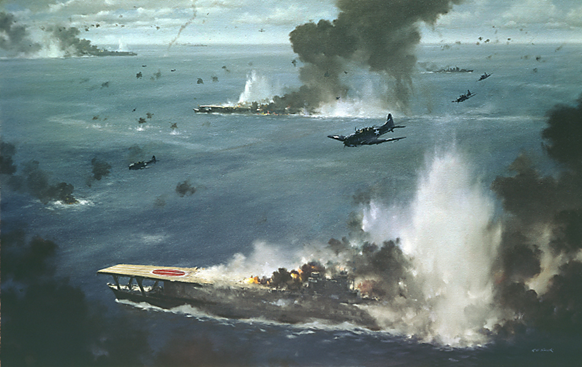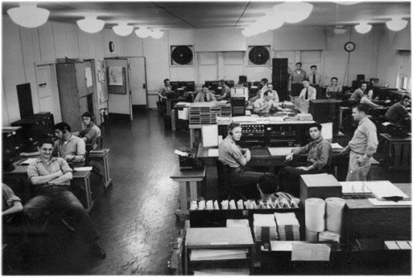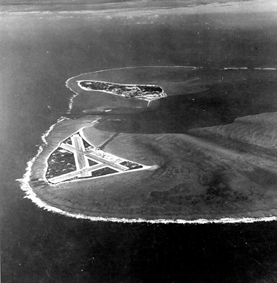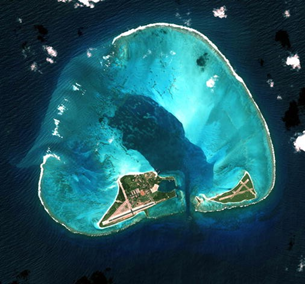
La batalla de Midway es quizás la más conocida de las batallas en la cual la radiointeligencia entregó una invaluable ventaja que permitió a Estados Unidos obtener el triunfo. Sin embargo, ¿fue realmente la radiointeligencia la que permitió ganar la batalla? Sin esa ventaja ¿tenían posibilidades los estadounidenses de haber derrotado a los japoneses en Midway?
The Battle of Midway, where radio-intelligence provided an invaluable advantage, is perhaps the best-known naval combat that enabled the United States to succeed. However, was it really radio-intelligence that enabled the battle to be won? Without that advantage, would the Americans have had any chance of defeating the Japanese at Midway?

The Battle of Midway is one of World War II´s most studied naval battles. More than a few readers must had read something about the importance that intelligence played in this US naval victory. Some may even recall the importance the "AF" bigram had in asserting that this decisive naval-air action would take place in the vicinity of Midway atolls. But was it really radio intelligence, also known as communications intelligence, that made it possible to win the battle? Without it, would the Americans have had any chance of winning?
Based on testimonies, and some recent publications, undisclosed for several decades, we will try to answer these questions. We will analyze how American radio intelligence worked, the results obtained, and its contribution to the war effort in the first months of this world conflict. We will describe the organizational and human relationship problems that affected the various components of the US communications intelligence community. Also, the information Admiral Nimitz had upon which to make crucial decisions, the most important being his trust in the intelligence information available, prior to this event. Finally, we will evaluate if the outcome of this great naval victory was due to radio intelligence.
 Commander Joseph Rochefort, Head of Station HYPO
Commander Joseph Rochefort, Head of Station HYPO
Communications Intelligence
In the early months of the war in the Pacific Theater, after the surprise Japanese attack on Pearl Harbor, there was little trust in intelligence, due to the failure in effectible alerting the attack, including the interception of enemy communications, known as Communications Intelligence (COMINT).
The United States lacked traditional intelligence sources, such as aerial reconnaissance/photography, nor did they have diplomats or spies on Japanese territory. The only source that could predict upcoming Japanese activities was communications intelligence. This tool, unknown and shrouded in secrecy, was, until then, untested in combat and mistrusted within the military community.
Radio intelligence worked in two different ways, both in mutual support: The first, signal intelligence was tasked in traffic analysis, i.e., studying the intercepted messages, such as the transmitters, recipients, transmission frequencies, amount of traffic and, if possible, the radiolocation of the transmitter. This was executed by two or more radio interception stations, via radio-fixing signal bearings. The second method was via cryptanalysis, gathering the contents of wireless messages, usually encrypted. This involved a complex process of codebreaking to obtain the message´s contents.
In the early months of 1942, U.S. Navy communications intelligence was centralized in the so-called "OP-20-G" in Washington DC. The organization maintained ten intercept and radiolocation stations located throughout the Pacific. The main stations were "Station CAST" in Cavite, Philippines and "Station HYPO”, also known as “Fleet Radio Unit Pacific” (frupac) in Pearl Harbor, Hawaii. Although these two stations supposedly reported directly to Washington, for practical reasons, especially HYPO, had a direct relation with the local Fleets. Commander Joseph Rochefort, an expert in cryptanalysis, plus in Japanese language and culture, was Head of Station HYPO. He was skeptical of OP-20-G, specially of its new boss, Commander John R. Redman. Reedman, almost immediately after the attack on Pearl Harbor, had relieved Commander Laurance Safford as head of communications intelligence and cryptanalysis. Safford was a respected organizer and pioneer of COMINT in the US Navy. One of the first steps taken by Commander Redman was to centralize all cryptanalysis in Washington. Commander Rochefort knew these proceedings would take months to work effectible and was unwilling to comply with.
The main target of the US Navy's cryptanalysis was the Japanese naval operational codebook JN-25. To understand the difficulties in breaking this code, it should be noted that the Japanese morse code is different from international Morse. To intercept the Japanese signals, the American radio operators had to have special training in this type of Morse, so as to intercept and transcribe the intercepted signals and then send their results to the main stations with cryptanalysis capability.
Initially HYPO was not authorized to work with JN-25 signals, but before he was relieved, Commander Safford approved Rochefort's Station Hypo to also work in breaking JN-25´s code.
With station CAST´s support and an exponential increase in the amount of intercepted traffic, station HYPO started decrypting the "B" version of JN-25 which had been implemented a few days before the attack on Pearl Harbor. The British contribution to the Americans was of great help in deducing the mathematics of operation and its deciphering. At that time, the cryptanalysts at Bletchley Park were successfully working on decoding the German Enigma cipher. In reality, because of the complexities of the Japanese language, nothing could be deciphered, since it was only possible to obtaining just some of the 33,000 five-digits numerical groups. These had some meaning only if they had a code book that could translate them into words or phrases.
But the Americans, after decades of studying the Japanese codes, already had a fraction of them, and had partially broken the previous version, the JN-25A. In addition, the Japanese committed important operational errors encoding their messages, such as initiating them with phrases like; "I have the honor to inform your Excellency," These errors allowed breaking the codes by knowing the plaintexts and its cipher equivalent. This time-consuming task of filling-in the codebook was hard and painstaking, plus, the operators had to then analyze and deduct its contents.
On the other hand, in April 1942, the American communications intelligence in the Pacific was going through rough times. Some intercept stations had been lost to the Japanese (Guam and Wake). Even station CAST had to be moved to Australia as “Fleet Radio Unit, Melbourne”. Nevertheless, the Americans were able to decipher signals that allowed them to deduct that a rather important Japanese naval operation would take place in the southwest Pacific.
The battle of the Coral Sea
In the first week of April, after months of hardworking in the cold basement of Station HYPO, affectionally dubbed as “the dungeon”, cryptanalysts deduced that the task force invasion code was related to the bigram "MO." According to these analyses, which were believed corresponded to specific geographic sectors, HYPO concluded that "MO" must correlate to Port Moresby, on the southern coast of New Guinea. Day after day new information was added, linking the Japanese Fourth Fleet, including the Fifth Carrier Division (Shokaku and Zuikaku) and a Cruiser Division, to this operation.
By the end of April, US Pacific Fleet intelligence officer, Lieutenant Commander Edwin Layton, in permanent contact with Commander Rochefort, had a clear picture of Japan´s Navy forthcoming operations. Furthermore, updated traffic analysis confirmed a concentration of surface ships in the vicinities of Rabaul and Truk, indicating the imminent launching of major operations in the Coral Sea.
The Commander-in-Chief of the Pacific Fleet (CINCPACFLT), Admiral Chester Nimitz trusted the intelligence reports and prepared his naval forces to encounter the attack, sending his two available carriers (Yorktown and Lexington) to the Coral Sea. The remaining carriers, USS Enterprise and USS Hornet were at that time in route to bomb Tokyo with Colonel Doolittle´s B-25 bomber aircrafts. This raised many doubts in Washington; it would be a mistake to send the remaining two carriers in the wrong direction, leaving Hawaii unprotected. In Washington, Commander Redman didn´t trust Rochefort's deductions. Furthermore, he was upset that HYPO had kept OP-20-G out of the loop. In his new reorganization, these kinds of strategic-level conclusions were his office´s exclusive attributions, not by a station in Hawaii, which was to work at a tactical level. Consequently, Redman raised his concerns directly to Admiral Ernest King, then Chief of Naval Operations.
Faced with such diverse interpretations and the importance of what was at stake, Admiral King asked Commander Rochefort his estimate of Japanese future operations. In less than six hours Rochefort, with copy to Admiral Nimitz, gave the following assessment to the CNO; First, that the Japanese navy would finish their current operations in the Indian Ocean, that they had no plans to invade Australia, that on the first week of May they would operate in the Coral Sea to invade Port Moresby, and subsequently would execute an even larger operation at a place and date yet unknown.
This assertive response convinced Admiral King, which later proved to be correct. The Japanese naval operations were executed as anticipated. On May 7-8, 1942, the first carrier-to-carrier battle in naval history took place. Although, in terms of ships sunk, its results were considered a triumph for the Japanese navy, the battle proved to be a strategic victory for the United States. For the first time since the beginning of the war, Japan could not fulfill their long-term plans. The IJN lost an aircraft carrier, and the other carrier could not be repaired in time to join the main fleet the following month, in the battle of Midway. On the other hand, the intelligence obtained through the interception of communications was tested for the first time in combat.
 Station "HYPO ", Pearl Harbor
Station "HYPO ", Pearl Harbor
The Japanese operation against AF
Admiral Yamamoto was planning the final details of a complex operation to defeat the US Pacific Fleet, confident that Admiral Nimitz, to defend Midway, had to risk his valuable carriers. Knowing that something particularly important was in the works, American radio intelligence stations continued trying to predict future enemy operations. Where would the next attack take place, when, and with what forces?
Early clues indicated Japanese carrier movements, as well as the conformation of a strike force and an invasion force. Associated with these activities, on May 13th messages were deciphered in which a Japanese logistics ship requested nautical charts of the Hawaiian area. This ship was tasked to transport aviation fuel assigned for AF. The primary target of the operation was AF. But... Where was AF?
It was known that these bigrams indicated geographical points, and almost certain that those bigrams beginning with the letter "A" corresponded to US geographical places. Also, that AF must have an airstrip. Previously that bigram had been detected in other interceptions. In March HYPO and CAST had preliminarily assessed AF as Midway. Rochefort was certain that AF was Midway and promptly convinced Commander Layton of this.
 Admiral Chester Nimitz, Commander-in-Chief, Pacific Fleet
Admiral Chester Nimitz, Commander-in-Chief, Pacific Fleet
But Admiral Nimitz was not convinced, he thought the target could be Hawaii or even the United States´ Pacific seaboard. Nimitz sent Commander Lynde McCormick, one of his most trusted staff officers, along with his intelligence officer, Commander Layton, to Station HYPO, where they were to analyze all the records and evidence concerning AF. McCormick was convinced, and at the same time astonished, by the work elaborated at HYPO. However, Station CAST was no longer sure that AF correspond to Midway. In Washington they were even less convinced, thinking that the Japanese attack could happen in places such as Alaska, Australia, Hawaii, or the west coast of continental USA. OP-20-G went even further and pointed out that all the argumentation associating bigrams with geographic locations was wrong. They estimated that they were just telecommunications zones across the Pacific. The human relations between the heads of Station HYPO and OP-20-G were quickly deteriorating. Something conclusive had to be done to confirm that AF was in fact Midway.
Station HYPO came up with a bright idea. To identify AF without any doubt, they switched roles, from radio interception to communications deception. A message was sent to Midway by submarine cable (impossible for the Japanese to intercept) ordering them to send a false message in plain language, stating that they had problems in the desalination plants, were short of fresh water and needed it urgently. Subsequently, Hawaii responded Midway in the same method, informing them that fresh water was on its way ASAP.
Two days later, HYPO intercepted a Japanese message, in which they informed that AF was having water problems. AF was then confirmed as Midway.
Despite the clarity of the evidence, there were still some persons (especially in OP-20-G) who did not believe that Midway was the target. How could two small islands located over a thousand miles from Hawaii be so important? It had to be a deceit.
Then another message was intercepted by HYPO which indicated that between D-2 and D day, strikes were to be initiated from a direction northwest of AF. Admiral Nimitz ordered his three carriers to return to Pearl Harbor as soon as possible. He also instructed Midway to increase aerial reconnaissance and sent submarines from Pearl to patrol areas northwest of these islands.
By linking cryptanalysis and traffic analysis information, CINCPACFLT HQ decipher the Japanese Order of Battle. The main attack force would be 1st Air Fleet, commanded by Admiral Chuichi Nagumo. This Fleet consisted of the 1st Carrier Division (Akagi, as flagship and Kaga) and the 2nd Carrier Division (Hiryu and Soryu), the 3rd Battleship Division, the 8th Heavy-Cruiser Division and the 10th Destroyer Squadron.
All that remained was to determine the day and time of the launching of operations. Commander Rochefort and his team obtained this information on May 27th by breaking the date-encryption. The strike would begin on June 4th. The invasion force would arrive two days later. Correlating all available information, Commander Layton determined that by 0755 hours on the 4th, the Japanese carriers would be on bearing 325° and 175 nautical miles from Midway.
To surprise the Japanese carriers, Admiral Nimitz issued his Operations Order by which his carriers would hit them with all available squadrons. Onboard USS Enterprise, upon receiving the intelligence estimates, some officers commented in amazement; "That man we have in Tokyo is worth every cent we pay him."
At midnight of that same day, the Japanese had completed the new JN-25 code, switching from version "B" to "C". This procedure had been delayed for several weeks, due to difficulties in delivering the new codebooks to all its users. That night, the entire US cryptanalysis capability became blind. The long process had to be started all over again and for several weeks, no positive results would be obtained. But all the information the US Pacific Fleet needed to know to oppose the Midway attack, location, date, and forces involved, was already accessible for them to exploit.

 Midway in 1942 Midway today
Midway in 1942 Midway today
The Battle of Midway
At 0800 hours on June 4th, the Japanese carriers were detected. They were 180 miles, 320° off Midway islands. Admiral Nimitz, satisfied on having relied on his N-2 officer, remarked to Commander Layton; “Well, you were only five miles, five degrees and five minutes off!
Further on, by monitoring enemy tactical communications, HYPO obtained unrelated information, but, piecing them together, it gave an idea of how the battle was developing. Early on, they had determined that a Japanese seaplane had detected part of the American forces. Subsequently, these communications were reporting significant losses of American aircraft in their attacks on Japanese carriers. Later, traffic analysis determined that IJS Hiryu was transmitting messages to Admiral Nagumo using cruiser Nagara's call sign, thus indicating that something serious had happened to carrier Akagi.
Afterwards, information obtained by COMINT proved that not all intelligence was perfect. A task group, identified as “the main body” (consisting of an escort carrier, three battleships, a cruiser, and some destroyer escorts), was located by determining the presence of its flagship, the battleship Yamato, a few hundred miles northwest of Midway. This task group, under the command of Admiral Yamamoto, was not included in HYPO´s estimated Order of Battle.
By nightfall official information of the battle reached Hawaii: All four Japanese attack carriers were sunk or out of action thanks to devastating attacks by U.S. naval aviation dive bombers. The battle had been won.
Epilog
Despite its great contribution to Midway´s victory, Station HYPO Chief Joseph Rochefort, “the man in Tokyo”, received no official recognition from Washington, probably because he was made a scapegoat for the embarrassment of OP-20-G. Admiral Nimitz recommended Rochefort for a “Navy Distinguished Service Medal” but it was denied. Subsequently he got sidetracked from intended billets and was transferred to San Francisco as commanding officer of a floating drydock. It was an unfortunate way to lose probably the best cryptanalyst in the US Navy. However, others assumed the task and continued obtaining communications intelligence throughout the war. Based on US Naval intelligence on Yamamoto's itinerary in the Solomon Islands area, in April 18th 1943, Admiral Yamamoto was killed on Bougainville Island when his transport bomber aircraft was intercepted and shot down by Army Air Force fighters operating from Kukum Field on Guadalcanal. For the Americans, assuming the risk of compromising the intelligence source, Pearl Harbor had finally been avenged.
Was Midway really a triumph of radio intelligence? Conclusions
Undoubtedly, by having a general picture of the enemy´s plan and forces involved, together with the dates, time, and location of the attack, prior to the engagement, is an invaluable advantage and significantly increases the chances of success in combat. However, intelligence alone does not guarantee victory. There always comes a point in which the outcome depends on persons and forces on the battlefield. This was the case at Midway; although many contributed to the victory, and radio intelligence certainly made the greatest contribution, the American victory belonged to the pilots who were able to use this valuable intelligence and destroy the Japanese carriers. However, even with all the advantages that intelligence provided, with bad luck (or better tactical decisions or even better luck for the Japanese), the Americans could just as easily have lost the battle.
Without radio intelligence´s valuable contribution, this battle would surely have had quite a different outcome. The American pilots would not have had the opportunity to attack the Japanese carriers. On the other hand, if the Japanese had had an equivalent radio intelligence capability, it is very unlikely they would have been surprised at Midway.
&&&&&&&&&&
La batalla de Midway, es, sin lugar a duda, uno de los episodios navales más estudiados por todos los marinos del mundo,...
Versión PDF
Año CXXXX, Volumen 143, Número 1008
Septiembre - Octubre 2025
Inicie sesión con su cuenta de suscriptor para comentar.-